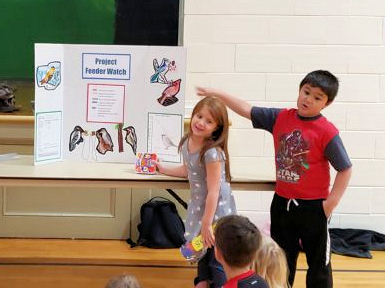
Woodpeckers are always a big hit with students, like this Downy Woodpecker (photo by Paul Konrad)

FeederWatch in the Classroom participants create feeding stations, then identify and count the birds that visit the feeders. Students also write school reports and prepare presentations about their participation in FeederWatch (photo by Sasha Hull).
|
Whether you are a student, parent, teacher, or an interested community member, you can encourage your local schools to add FeederWatch in the Classroom as a part of class curriculums for young people ranging from pre-school to college. It’s a great topic to cover for public schools, home schools, and private schools to get students involved in projects that include birds and nature, and during winter months – school months – a meaningful, interesting, sometimes exciting way to engage children is to get them involved in Project FeederWatch.
Now is the best time to join up or renew for the 2021-22 Project FeederWatch season, which begins November 13th and runs through April 30. If your school class is a first-time FeederWatch participant you will receive the colorful east-west, double-sided bird identification poster, along with a FeederWatch calendar, and you can download all the information about how your class can participate. It’s time to start getting ready for the coming Project FeederWatch season by reading the online instructions (you can also print out the .pdf file), then begin counting birds at your feeder(s) and bird bath when the season starts.
It’s a great way to get students physically involved by having them stock the feeders with appropriate foods, provide fresh water daily, and keep the area and feeders clean. Imagine all the different lesson plans that can be developed about the birds you see: Life history information about the individual species of birds, learning about feathers, bird migration; different types of feeders, different kinds of foods and the birds that eat them; nesting, incubation, and raising nestlings – the potential is expansive.
Students can also read books, collect information, and prepare presentations and class projects with birds as a focus. Just watch how children react to birds, whether they are high school biology students or in a grade school science class. No one is too young or too old to participate in Project FeederWatch, and you can always participate in FeederWatch at home too!
There is a long history of classroom participation with this year’s event, which marks the 35th annual Project FeederWatch season, and there is a host of alumni who have enjoyed the experience as part of their participation in this citizen-science project. In addition to the activities students and other participants enjoy and learn from, researchers can access the data provided by students and birders from across the United States and Canada to study trends and changes in winter bird populations over extended periods of time. This information can help develop research and conservation projects that benefit our local, regional, and continental bird populations. That’s right, FeederWatch is fun and important!
To learn about how school classes have participated in recent years, it’s very interesting to read the descriptions provided at Schools Archives - FeederWatch
To learn more about how your class can get involved and benefit from Project FeederWatch, download the Project FeederWatch Handbook & Instructions at How to Participate - FeederWatch And for more information, see FeederWatch - Count Feeder Birds for Science
Share your backyard birding experiences and photos at editorstbw2@gmail.com